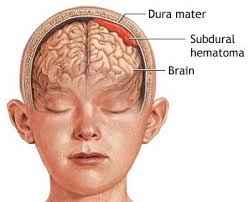A hematoma, (रक्तगुल्म) also spelled haematoma, is localized bleeding outside of blood vessels, due to either disease or trauma including injury or surgery, and may involve blood continuing to seep from broken capillaries. A benign hematoma is initially in a liquid form spread among the tissues including in sacs between tissues where it may coagulate and solidify before blood is reabsorbed into blood vessels. Ecchymosis is a hematoma of the skin larger than 10mm. They may occur among/within many areas such as skin and other organs, connective tissues, bone, joints, and muscle. Blood seepage and collection of blood may occur if heparin is given via an intramuscular route; to avoid this, heparin must be given intravenously or subcutaneously. It is not to be confused with hemangioma, which is an abnormal buildup/growth of blood vessels in the skin or internal organs.
Hematoma Meaning
The term “hematoma” is derived from two Greek words: “haima,” meaning blood, and “toma,” meaning swelling or mass. Therefore, the word “hematoma” literally translates to “blood swelling” or “blood tumor.” In medical terms, it refers to a localized collection of blood that has leaked out of blood vessels, usually as a result of trauma, injury, or some form of vascular damage. Hematomas can occur in various tissues or organs throughout the body.
Types of Hematoma
Hematoma Symptoms
Causes of Hematoma
Diagnosis of Hematoma
Home remedies for Hematoma
Conclusion
In conclusion, a hematoma is a localized collection of blood outside blood vessels, typically occurring due to injury, trauma, or underlying medical conditions that cause blood vessel damage. The symptoms of a hematoma include swelling, pain, and discoloration of the skin. While small hematomas may resolve on their own, larger or more severe cases may require medical intervention, such as rest, ice, compression, elevation, pain medications, and, in some instances, drainage procedures. The type and severity of the hematoma, along with its underlying cause, guide the appropriate treatment approach. It’s crucial to seek prompt medical attention for proper diagnosis and management of hematomas, ensuring a comprehensive and effective approach to recovery.
Frequently Asked Questions
Reference: https://en.wikipedia.org/wiki/Hematoma


I do trust all the ideas youve presented in your post They are really convincing and will definitely work Nonetheless the posts are too short for newbies May just you please lengthen them a bit from next time Thank you for the post
Step into the Kaleidoscope of Desire at Erotoons.net. Here, stories aren’t just told; they are vividly painted across the canvas of imagination, inviting men and women alike to bask in their glory. Our collection is a symphony of adult tales, each resonating with the tune of temptation and allure. And the ticket to this grand show? It’s on us. Erotoons.net doesn’t just offer free adult comics; we present a world where every turn is a new discovery, a journey accessible to everyone seeking to quench their thirst for erotic adventures.
Need a dose of fantasy to spice up your evenings? Look no further. Erotoons.net offers a vast collection of sultry summer 3 porn comic to satisfy your desires.
Wow, superb weblog structure! How lengthy have you ever been running a
blog for? you made blogging glance easy. The total glance of your web site is excellent, let alone the content material!
You can see similar: najlepszy sklep and here sklep online
Thanks a lot for your kind attitude and the precious words. Please stay tuned. Have a nice day!!
as57m5
Thanks a lot for your kind attitude and precious words. Please stay tuned and have a nice day!!
Можно ли быстро купить диплом старого образца и в чем подвох?